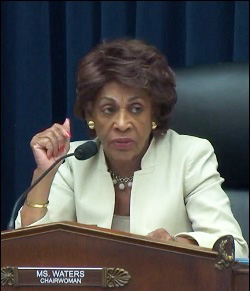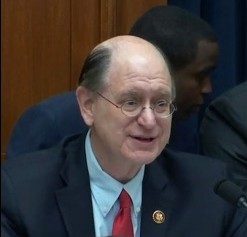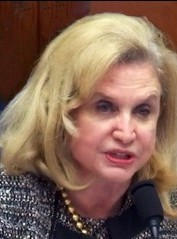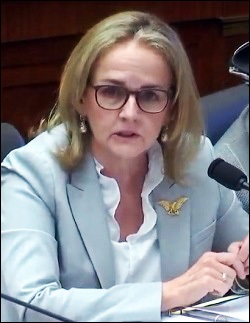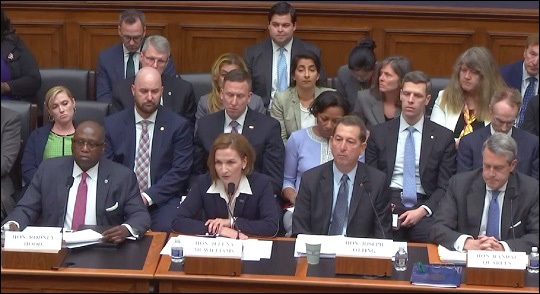
House Financial Services Committee Hearing, May 16, 2019. Left to Right: Rodney Hood, Chair of the National Credit Union Administration; Jelena McWilliams, Chair of the Federal Deposit Insurance Corporation; Joseph Otting, Head of the Office of the Comptroller of the Currency; Randal Quarles, Vice Chairman for Supervision at the Federal Reserve.
By Pam Martens and Russ Martens: May 17, 2019 ~
At a House Financial Services Committee hearing yesterday, Republicans attempted to marshal arguments for why U.S. banks needed more relief from regulatory oversight. Those arguments weren’t helped by the news of the day. As the hearing got underway, headlines were being promulgated around the globe that JPMorgan Chase, Citigroup and three foreign banks had been fined $1.2 billion by the European Commission for rigging foreign exchange markets. The U.S. Department of Justice leveled criminal felony charges on the same two U.S. banks in 2015 for rigging the same market. Both banks admitted to the charges at that time.
A decade after the greatest financial crash in the United States since the Great Depression; after the Dodd-Frank financial reform legislation has failed miserably in stopping the ongoing crime spree by Wall Street’s largest banks; and as radical right-wing members of Congress together with the President continue to chip away at the few safeguards that still exist for the public against these predatory behemoths, the new Chair of the House Financial Services Committee, Maxine Waters, had the courage to convene yesterday’s hearing to put the spotlight on the people who regulate the Wall Street banks. (Missing from the lineup for unknown reasons was the Chair of the Securities and Exchange Commission and the Chair of the Commodity Futures Trading Commission.)
The witness panel included Jelena McWilliams, Chair of the Federal Deposit Insurance Corporation (FDIC) – a Federal agency that would not have anywhere near enough money to bail out even one of the Wall Street mega banks if it got into trouble; Joseph Otting, head of the Office of the Comptroller of the Currency (OCC), whose career number-crunchers have quietly been producing data showing that JPMorgan Chase’s Federally-insured bank has a $2.2 trillion position in stock derivatives and that Goldman Sachs Bank USA, also a taxpayer backstopped bank, has a stunning 354 percent total credit exposure to capital as a result of its massive derivatives holdings. Then there was Randal Quarles, Vice Chairman for Supervision at the Federal Reserve – the body that kept Congress in the dark during the financial crisis as it secretly funneled $29 trillion to bail out teetering Wall Street banks and hedge funds and insolvent institutions like Citigroup – even though it is not legally allowed to make loans to an insolvent institution.
The Federal Reserve had the temerity to fight the media in court for years in an effort to keep this unprecedented $29 trillion money spigot a secret from Congress and the American people. The information only became public after the U.S. Supreme Court refused to hear the appeal and Senator Bernie Sanders attached an amendment to the Dodd-Frank financial reform legislation mandating an audit of the Fed by the Government Accountability Office.
Also appearing as a witness yesterday, but having nothing to do with the banks other than a highly unequal playing field, was Rodney Hood, Chair of the National Credit Union Administration.
The most important exchange of the day occurred between Brad Sherman, a Democratic Congressman from California and Randal Quarles of the Fed. It went like this:
Sherman: Mr. Quarles, I think you probably regulate the biggest of the big. Can you guarantee us that no one institution will be able to call the White House or Congress and say ‘we’re going down, and when we go down, we’ll bring down a chunk of the economy with us.’ They did that 10 years ago. Can we just hang up on them now if they make that call. And don’t tell me it’s unlikely to happen, because, trust me, your predecessor’s predecessor told us in 2007 it wasn’t going to happen.” [That was a reference to Alan Greenspan, the infamous see-no-evil, hear-no-evil, speak-no-evil when it comes to banks, former head of the Fed.)
Quarles: “There have been substantial improvements in the resolvability of all of the large institutions.
Sherman: So, can you guarantee if they call, we can hang up the phone. You’re not gonna be here saying, oops, you better pass TARP II.
Quarles: What I can guarantee is the changes that have been made will give policy makers, including the Congress, more options than existed 10 years ago…
Sherman: For those of us who lived through it, that’s not a whole lot of comfort. We can guarantee that if we break up the too-big-to-fail institutions. And I’m still looking for co-sponsors, particularly bipartisan co-sponsors, on that effort.
Why every American should think carefully about this exchange is the following. The FDIC’s Deposit Insurance Fund, as of December 31, 2018, had only $102.6 billion in its coffers. The domestic deposits of just three Wall Street mega banks — JPMorgan Chase, Citigroup’s Citibank, and Bank of America – total $3.2 trillion. And these are the same three Federally-insured banks that are taking major risks by holding trillions of dollars in derivatives – the majority of which regulators have very little transparency into, the precise situation that led to the severity of the 2008 Wall Street collapse that took down the U.S. economy.
Congresswoman Carolyn Maloney, Democrat from New York, continued along the same basic theme when she inquired about one of the stiff provisions of the Dodd-Frank reform legislation, the Volcker Rule, named after a former Chair of the Federal Reserve, Paul Volcker. The rule was meant to end proprietary trading (trading for the house) at the Federally-insured Wall Street banks and prevent their ownership of hedge funds and private-equity funds. Those activities are embedded with risks that can collapse the whole bank. Dodd-Frank was passed in 2010 and the Wall Street lawyers and lobbyists succeeded in stalling the implementation of the Volcker rule for years. Now it is so watered down that it is hardly recognizable and Trump’s appointed regulators are under pressure to water it down further. Maloney’s questions on the matter went like this:
Maloney: “As you know, when the regulators finalized the Volcker Rule in 2013, they required banks to report a significant amount of data on their trading activities to the regulators, so that the regulators could monitor whether banks were complying with this rule. You’ve now been collecting detailed trading data from all of the banks for over five years. So if there were problems with the Volcker Rule in practice, almost all these problems would have shown up in the data. But when you proposed an overhaul of the Volcker Rule last year, you cited virtually no actual data to support any of the sweeping changes you were proposing to the rule – not even aggregated high level data. None. Zippo. Instead, the proposal justified nearly every significant change by citing “experience with the rule.” With no further explanation, no further evidence whatsoever. By my count, the agencies cited their experience with the rule, rather than actual data, a total of 37 times in last year’s proposal…That is simply unacceptable. There is nothing in the law preventing the agencies from disclosing this trading data on an aggregated basis to provide transparency into this critically important rule. So my question is, before the agencies finalize any changes to the Volcker Rule, will you commit to disclosing aggregated trading data to the public, and in a way that properly protects confidential supervisory information and that demonstrates the need for any overhaul for the rule.
Quarles: That’s a very reasonable request. We received it from others as well as part of the comment process. We’re actively looking into how to aggregate this data. The data as we collect it, as you’ve noted, is confidential supervisory information. Determining how to disclose it in an aggregated way that doesn’t disclose the underlying confidential information is not an easy task but we’re actively looking at it.
Maloney: When will we be able to have this data to look at.
Quarles: As part of our response to the comments as we receive them, we’re looking as to how we could make some of this aggregated data public.
Maloney: But when would that be.
Quarles: We’re expecting to complete this next step in the Volcker Rule process over the next 60 to 90 days.
Congresswoman Madeleine Dean, a Democrat from Pennsylvania, asked about the $300 billion in fines the banks have paid for various crimes since the financial crash in 2008. The exchange went like this:
Dean: We had the big banks in here a couple of weeks back. It was a very enlightening hearing. I don’t even have a current tally, but one of the themes that kept recurring was the banks since 2008 have suffered, or have been imposed upon, with more than $300 billion worth of fines. I’m wondering what is your reaction, as very important regulators, to that climate. While they came in, said they’re healthy, they’ve reduced risks and they’ve streamlined and they’re profitable, they have suffered fine, after fine, after fine. And so consumers think, is that just the cost of doing business. So what do you, as regulators, think of $300 billion plus in fines on the big ones, Bank of America, JPMorgan Chase, Citigroup, Deutsche Bank, Wells Fargo and I can go on and on and on…
Otting: “…I’m very comfortable that we are on site, we are regulating those institutions and fines are the byproduct of when we find harm and activities…”
Dean said she was sure the regulators were doing their job. But, clearly, they are not doing their job or the crimes would not be continuing at the same banks. Jamie Dimon has been the Chairman and CEO of JPMorgan Chase since before the financial collapse. In 2012 his Federally-insured bank was caught trading hundreds of billions of dollars in high-risk exotic derivatives in London. The bank lost at least $6.2 billion of its depositors’ money in that scandal. The bank paid over $1 billion in fines and settlements but Dimon kept his job. In 2014 Dimon’s bank was charged and admitted to two felony counts for its involvement in the Bernie Madoff Ponzi scheme. For the first time in its more than a century of existence, it became a felon. Dimon kept his job. The very next year, 2015, the bank admitted to another felony count for rigging foreign exchange trading. Dimon kept his job. What kind of Federal regulators let the same man sit at the helm of the largest bank in the U.S. after three felony counts on his watch and after he has allowed depositors funds to be gambled away in London to the tune of $6.2 billion in losses.
To an engaged observer, these Wall Street banks look more and more like a crime syndicate and their regulators look like either lackeys or interns for the crime syndicate. See the April report from the nonprofit watchdog, Better Markets: “Wall Street’s Six Biggest Bailed-Out Banks: Their RAP Sheets & Their Ongoing Crime Spree.”
Yes, this was a tedious 3-1/2 hour hearing to sit through. But if you’re not paying attention to what these mega banks and their regulators are up to, you’re likely to become their next victim.

